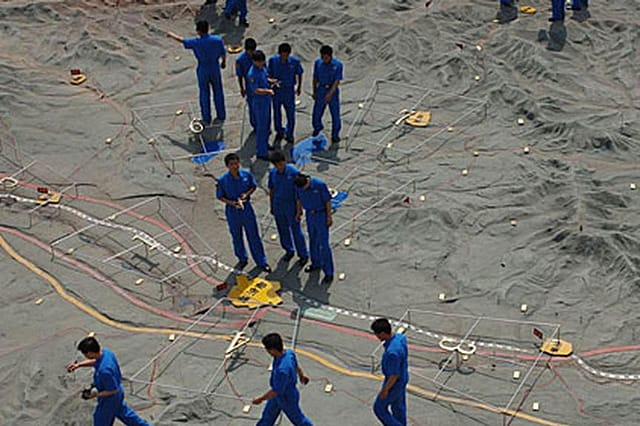Beijing has an eye on Ladakh’s rivers

While there is a lively social media debate on between Colonel Ajai Shukla (Retd), the Strategic Affairs Editor of Business Standard, and General VK Singh (Retd), currently Minister of State for Road Transport and Highways, on whether or not the Chinese have "pulled back", the central question still remains unanswered. Why would the Chinese spend so much money, lose close to a hundred soldiers and accept curbs on their investment in India, have 59 popular Chinese apps banned and acquire an enormous amount of ill will throughout India and the Indian diaspora worldwide if they had to pull back their forces from the first line of advance in eastern Ladakh?
It has come to light that the Chinese have built a 1:500 scale terrain model of Ladakh at Ningxia in the geographic centre of China. This terrain model was apparently revealed in satellite imagery over a decade ago and accurately identifies topographical features such as the lakes, rivers and mountain ranges of Aksai Chin and other parts of Ladakh. That China would go to such lengths to study the landscape of Ladakh, underscores the vital importance of this region to China.
Why is this region so important to China? Earlier, the importance was because of the substantial deposits of uranium, thorium, beryllium, molybdenum, petroleum and gold. These have largely been extracted. Today, the importance is because of water.
2026 New Year Issue
Essays by Shashi Tharoor, Sumana Roy, Ram Madhav, Swapan Dasgupta, Carlo Pizzati, Manjari Chaturvedi, TCA Raghavan, Vinita Dawra Nangia, Rami Niranjan Desai, Shylashri Shankar, Roderick Matthews, Suvir Saran
I will now turn to the three images of historical discharge technically known as streamflow or volumetric flow rate data for the Shaksgam, Galwan and Chang Chenmo rivers, respectively, that run through Ladakh. These have been supplied by an acquaintance of mine called Tushar Sethi who runs a British company called Margosa Environmental Solutions. They have taken this satellite-generated data with a 1 km resolution from points upstream and downstream from these three rivers to give a sense of the build-up of water volume along parts of the rivers. Since the Chinese have a terrain model of Ladakh, it is presumed that they already have this data. The Galwan river data is taken at the point of the recent incursion by the People's Liberation Army (PLA). While hydrologists can interpret this data in specific hydrogeological contexts, for the purposes of my argument, the following points need to be emphasised:
– The Chinese are using this data to interpret India's future water planning and infrastructure development.
– They are using this data for positioning their offensive forces and building up their own logistics and infrastructure.
– They have developed an excellent and well-informed negotiating position on territorial and riparian rights concessions.
– That because of global warming, glacial melt has accelerated in the western Himalayas and the Karakoram ranges.
– This glacial melt is going to cause an increase in the water surging through these rivers that ultimately merge with the Indus.
– The Chinese plan to take advantage of this surge and are constructing the Bunji and Diamer Bhasha dams at Skardu and Gilgit in PoK at a cost of nearly $14 billion.
– They want to enforce a secure solution to ensure unmolested flow of this surge of water to these dams.
Given such facts, it can safely be argued that the Chinese tactical withdrawal at Galwan is a temporary halt to assess if more territorial gains are possible without engaging in a kinetic war or whether they will have to get into a kinetic war in any case. They have close to five divisions facing the Indian Army's XV Corps in eastern Ladakh at present.
This, to my mind, is why the Chinese started advancing towards the LAC in Feb-March this year. It is inexplicable as to why strategic inputs in the form of satellite imagery and other allied intelligence tools were not shared with the Indian Army and why its summer exercises in Ladakh scheduled for April were abandoned on the pretext of Covid-19? What is the real game?
